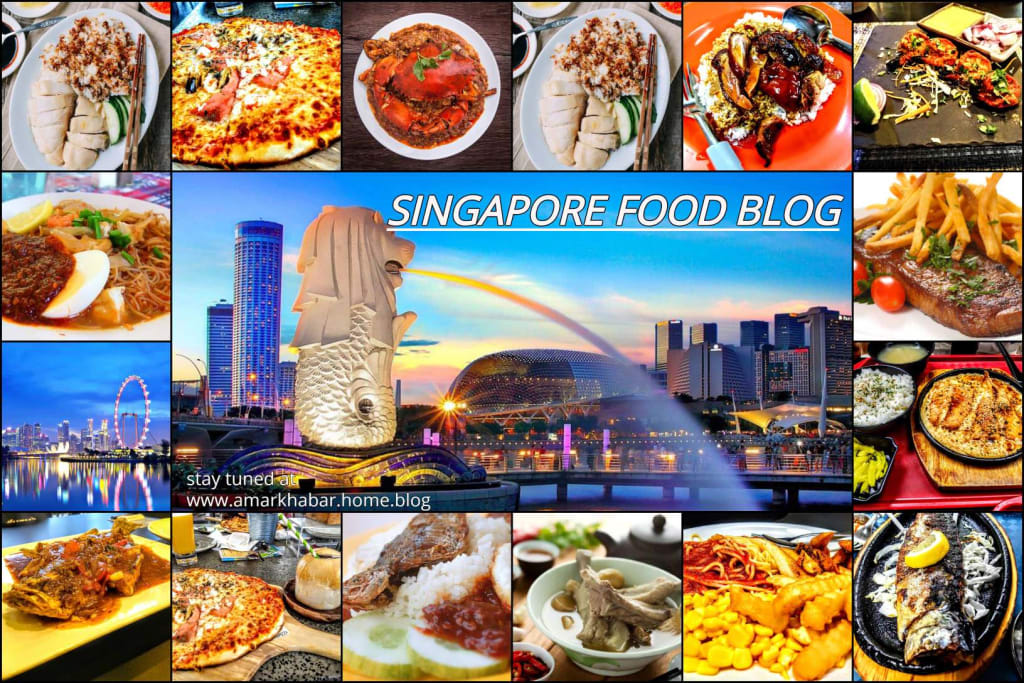The Gastronomic Tapestry of Singapore
A Dive into Its Popular Foods

Singapore is a city-state that thrives on its diversity and is frequently referred to as a "melting pot" of cultures. This diversity is best shown off in its food scene, where culinary traditions from different ethnic groups come together to make a delicious dish that is one of a kind. From peddler focuses clamoring with movement to very good quality cafés offering connoisseur encounters, Singapore's food culture is a rich embroidery that mirrors its set of experiences, multiculturalism, and imaginative soul. This article dives into the absolute most famous food sources in Singapore, investigating their beginnings, flavors, and the spots where you can appreciate these magnificent dishes.
Vendor Focuses: The Core of Singaporean Food Understanding the significance of hawker centers in Singapore is essential before diving into specific dishes. These outdoors buildings house a huge number of food slows down, each offering various dishes at reasonable costs. Hawker centers are not only places to eat, but also social hubs where people from all walks of life come together. They are known for their cultural and social significance. Underscoring its global significance, Singapore's hawker culture was included on UNESCO's Representative List of the Intangible Cultural Heritage of Humanity in 2020.
Hainanese Chicken Rice: A Public Symbol Frequently hailed as Singapore's public dish, Hainanese chicken rice is a basic yet glorious dish that typifies the magnificence of Singaporean cooking. Starting from Hainan, China, this dish was adjusted by early Chinese foreigners in Singapore. It consists of poached chicken served with fragrant chicken broth-cooked rice and three dipping sauces: dark soy sauce, chili with garlic, and ginger paste. The sorcery of Hainanese chicken rice lies in its execution. The chicken is delicate and damp, while the rice is sweet-smelling and tasty. Places like Tian Hainanese Chicken Rice at Maxwell Food Center have become incredible, drawing in the two local people and vacationers who line up for a sample of this culinary magnum opus.
Laksa: A Fiery Noodle Enjoyment Laksa is a zesty noodle soup that features the Peranakan cooking, a combination of Chinese and Malay culinary customs. Thin vermicelli or rice noodles are soaked in a rich, creamy broth made from coconut milk that is seasoned with chili, lemongrass, and shrimp paste. Laksa is a filling meal that typically includes prawns, fish cakes, and bean sprouts as garnish. Katong laksa, named after the Singaporean neighborhood of Katong, is one of the most well-known variations. The noodles of Katong laksa are cut into shorter lengths so that they can be eaten with a spoon, making them one of a kind. For a valid encounter, go to 328 Katong Laksa, a prestigious place where the equilibrium of flavors in the stock is idealized.
Bean stew Crab: A Blazing Fish Dining experience Singapore's bean stew crab is a dish that needs no presentation. This famous fish dish highlights crabs sautéed in a thick, zesty, and tart tomato-based sauce. The sauce, made with a mix of chilies, garlic, ginger, and a hint of sugar, covers the delicious crab meat, making a flavor blast in each chomp. In spite of its name, stew crab isn't excessively fiery, making it open to a great many palates. For this messy but absolutely delicious dish, seafood lovers flock to Long Beach Seafood and Jumbo Seafood. Chilli crab is a dish that is meant to be shared and is typically served with mantou, which are fried or steamed buns. This dish reflects the friendly atmosphere of dining in Singapore.
Hokkien Mee: A Delightful Noodle Sautéed food The beloved noodle dish known as hokkien mee has its origins in China's Fujian province. In Singapore, this dish is made by sautéing a blend of egg noodles and rice noodles with prawns, squid, and pork stomach in a rich stock produced using prawn heads and bones. The noodles are frequently embellished with a bit of sambal stew and a press of lime for an additional kick. The dish is commonly cooked in an enormous wok over high intensity, giving it a trademark smoky flavor known as "wok hei." For a sample of the best Hokkien mee, go to places like Nam Sing Hokkien Broiled Mee at Old Air terminal Street Food Center, where the harmony between surfaces and flavors arrives at flawlessness.
Satay: Barbecued Flawlessly Satay, a well known road food across Southeast Asia, is a must-attempt in Singapore. These sticks of marinated meat — typically chicken, hamburger, or sheep — are barbecued over an open fire and presented with a rich nut sauce, rice cakes (ketupat), and a side of cucumber and onion. The marinade normally incorporates a blend of turmeric, lemongrass, garlic, and shallots, injecting the meat with a profound, sweet-smelling flavor. In the evenings, Lau Pa Sat, especially its Satay Street (Boon Tat Street), transforms into a satay haven, with numerous stalls erecting grills and serving this delectable dish. The pleasant air, with smoke drifting from the barbecues and the sound of sizzling meat, makes for an extraordinary eating experience.
Nasi Lemak: A Malay Staple Nasi lemak, which means "rich rice," is a fragrant rice dish cooked in coconut milk and pandan leaf. Generally a Malay breakfast dish, it has turned into a well known dinner whenever of the day in Singapore. Sambal (spicy chili paste), cucumber slices, fried ikan bilis (anchovies), boiled eggs, sambal (spicy chili paste), and a choice of meat, typically fried chicken or rendang (spicy beef stew), are typically accompanied the rice. Visit places like Selera Rasa Nasi Lemak at Adam Road Food Centre for a traditional taste of nasi lemak. There, crispy fried chicken, spicy sambal, and creamy rice create a harmonious balance of flavors and textures.
Roti Prata: A South Indian Joy Singaporeans have embraced roti prata, a South Indian flatbread, wholeheartedly. Produced using batter that is flipped and extended until paper-slim, then collapsed and cooked on an iron until fresh outwardly and delicate within, prata is a flexible dish delighted in at breakfast, lunch, or supper. It is typically paired with fish or chicken curry as a side, but it can also be enjoyed with condensed milk or sugar for a sweet treat. One of the most amazing spots to enjoy roti prata is The Roti Prata House on Upper Thomson Street, where you can find a broad menu highlighting both conventional and creative varieties, for example, cheddar or egg prata.
Roast Kway Teow: A Sautéed Sensation One of the best examples of Singaporean street food is char kway teow. This sautéed noodle dish includes level rice noodles, Chinese wiener, fish cake, bean fledglings, and cockles, all threw together in a smoky, sweet, and exquisite sauce. The expansion of eggs and grease improves the extravagance of the dish, making it a fantastic and liberal feast. The perfect "wok hei," or the smoky flavor that comes from the high heat of the wok, is the key to a great char kway teow. For a plate of remarkable singe kway teow, go to Slope Road Broiled Kway Teow at Chinatown Complex Food Place, where the slow down's standing for quality and flavor draws long lines everyday.
Kaya Toast: A Favorite for Breakfast No investigation of Singaporean food would be finished without referencing kaya toast, a darling breakfast staple. Kaya is a sweet coconut and egg jam enhanced with pandan, spread liberally on toasted bread, and commonly presented with a cut of cold margarine. This basic yet heavenly blend is typically delighted in with delicate bubbled eggs and some solid, fragrant kopi (espresso). Ya Kun Kaya Toast, a well-known restaurant chain, offers this classic breakfast in its purest form. The blend of the rich, fragrant kaya with the fresh toast and runny eggs is a soothing method for beginning the day, offering a brief look into the regular daily existence of Singaporeans.
Bak Kut Teh: A Hearty Soup Made of Herbs Bak kut teh, which means "meat bone tea," is a vigorous pork rib soup enhanced with a complicated mix of spices and flavors. There are two fundamental styles of bak kut teh in Singapore: the Teochew variant, which has a reasonable, peppery stock, and the Hokkien rendition, which includes a hazier, more natural soup. White rice, dough fritters (youtiao), and preserved vegetables are typically paired with this dish. The delicate pork ribs and sweet-smelling stock make for a consoling and fulfilling feast. Visit Song Fa Bak Kut Teh, a well-known restaurant that has been serving this hearty dish since the 1960s, for an authentic taste of bak kut teh.
End Singapore's food scene is a lively festival of its multicultural legacy, where conventional dishes are treasured, and new culinary developments are embraced. From the clamoring seller focuses to the city's numerous diners, the assortment and nature of food accessible are a demonstration of Singapore's status as a worldwide culinary capital. Whether you're relishing the effortlessness of Hainanese chicken rice, partaking in the complicated kinds of laksa, or enjoying the rich hotness of stew crab, each dish recounts an account of social combination and culinary greatness. In addition to providing an opportunity to experience the rich tapestry of traditions and influences that make this city-state so distinctive, sampling Singapore's popular foods is a gastronomic journey.
About the Creator
Ovijit paul
I am a food blogger and I blog about popular foods from different countries. Hope you like my writings.
Enjoyed the story? Support the Creator.
Subscribe for free to receive all their stories in your feed. You could also pledge your support or give them a one-off tip, letting them know you appreciate their work.






Comments (1)
Hey, just wanna let you know that this is more suitable to be posted in the Feast community 😊